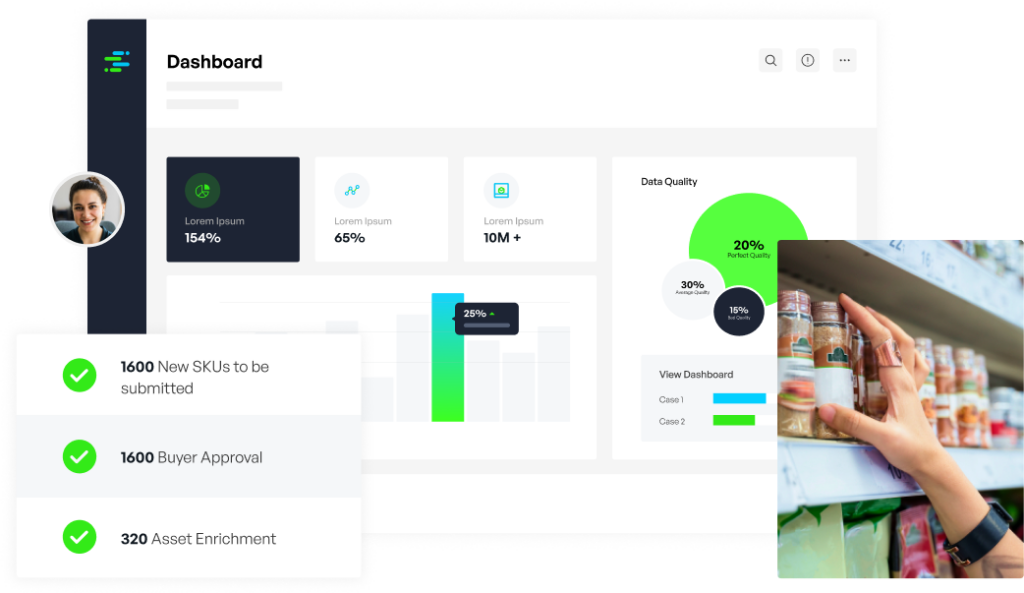
Product Information Management (PIM) is the critical business process of collecting, managing, enriching, and distributing product information and associated digital assets.
As omnichannel purchasing habits become more commonplace, companies need accurate, timely, and complete product data to personalize customer experiences and foster loyalty. PIM streamlines the process of managing complex product information and enables companies to distribute data quickly and consistently across teams and channels.
PIM systems store product-related data in one centralized location and enable users to enrich this information. A PIM platform increases the value of product information by making it more accessible and functional to users throughout the organization. With a PIM software solution, companies can enhance the product experience and successfully promote products through multiple sales, marketing, and eCommerce channels.
PIM solutions keep all business users on the same page throughout the entire product ecosystem by connecting with data pools, vendor data, marketplaces, eCommerce platforms, and Digital Asset Management (DAM) solutions.
This comprehensive approach ensures accurate, consistent, and updated information across all channels, fostering an engaging and effective product presentation.
How can your company go from having poor-quality product data to managing data that enhances customer experiences and boosts sales? It doesn’t need to be a mystery. With PIM, it’s a straightforward process.
Product Information Management (PIM) collects data through various sources, including supplier data feeds, data pools, Enterprise Resource Planning (ERP) systems, spreadsheets, and digital assets. The collection process involves importing this data into the PIM system either manually or automatically, often using APIs or data connectors.
For example, a retailer might use PIM to gather product specifications, images, and descriptions from multiple suppliers. By centralizing this information, PIM ensures that a comprehensive view of all product data is accessible in one location, creating a single source of truth.
A PIM solution effectively manages data by ensuring it is organized, accurate, and updated. The data management process begins with standardization — where the PIM system identifies and removes any inconsistencies or duplicates in the data collected from various sources. For instance, two suppliers may use slightly different terms for the same product feature. A PIM system will harmonize this disparate information into a standard term.
Moreover, PIM maintains data synchronization, which means that any change or update made to the product information in the PIM system is reflected across all channels in real time. So if a product’s price is changed in the PIM system, that change can automatically be updated wherever the product data is used, ensuring data accuracy and consistency.
Product Information Management systems enrich product data by augmenting it with additional details, thereby enhancing its value. This enrichment process can involve adding more in-depth product descriptions, additional specifications, customer reviews, or multimedia elements such as images and videos.
For example, the PIM system could enhance a basic product description imported from a supplier by adding material details, pairing suggestions, or instructional videos. The enriched data provides a more comprehensive and detailed view of the product, helping to improve the overall customer experience and providing the information they need to make a purchasing decision.
PIM systems play a vital role in distributing product data to various sales and marketing channels. Once the data is in the PIM system, it can be shared seamlessly with different channels, including eCommerce sites, marketplaces, and retail stores.
When a company wants to list a product on multiple online marketplaces, the PIM system can push the relevant product data to each channel, ensuring accurate and consistent information is available wherever the product is sold. This capability ensures all channels have the latest product information, maintaining a uniform brand image and a consistent customer experience across platforms.
Without a PIM system, each step in this process would be highly manual, prone to human error, time-consuming, and cost prohibitive. Which means, for most organizations, this essential and value-added data management wouldn’t get done. The beauty of a PIM system is that it automates each step, making it a feasible undertaking for any organization.
Product information can cover a broad scope of possibilities. What specific types of product information does PIM help organizations manage?
Product companies have various teams collaborating on product information. Depending on their roles and responsibilities, some teams will likely engage with the Product Information Management (PIM) system more frequently than others. To illustrate how this typically functions, let’s explore a few examples of how different teams might interact with a PIM system within their workflow.

Marketing teams create content used for various marketing campaigns across a number of channels. With PIM, they can update content quickly or modify it by channel while maintaining brand voice. Plus, they can optimize content for search directly within the PIM platform.
PIM makes it easy for analysts to build reports, track progress, and compare products. Because all product information is centralized, there’s no need to scour a myriad of systems or spreadsheets to find the data they need.
Sales teams want access to product information at a moment’s notice. With Product Information Management, they can access sales resources — such as product sheets, high-quality images, digital catalogs, and other digital assets — all from one location.
Using PIM, customer service teams have all product information at their fingertips to answer customer questions. This product information access expedites service calls, allows the team to help more customers, and improves the customer experience at a crucial time.
With its single source of truth, teams can trust the product information in PIM is accurate. By eliminating disparate data sets and silos, teams collaborate faster and more efficiently.
Product Information Management not only makes managing data easier and more efficient — it can have a direct impact on your bottom line in several ways.
By streamlining data management, PIM can save time and reduce costs associated with manual data entry and error correction, freeing up resources for other essential tasks.
By ensuring accurate, detailed, and consistent product information across all sales channels, PIM enhances the customer experience. Positive customer experiences lead to increased loyalty, positive brand reputation, and repeat purchases.
PIM can drive increased sales by providing accurate, enriched product information across all sales channels. Rich and engaging product descriptions influence customer purchase decisions, leading to higher conversion rates.
With the enhanced accuracy of product information, customers have a clear understanding of what they’re purchasing, reducing the likelihood of product returns due to mismatched expectations.
PIM systems streamline the process of launching new products or updating existing ones. The ability to quickly distribute updated product information to all sales channels reduces time-to-market, giving businesses a competitive edge.
With a holistic view of product data, companies can identify related products more easily. This can facilitate more effective cross-selling and up-selling strategies, boosting average revenue per customer and transaction.
PIM helps eliminate data silos, manual data entry, and other inefficient practices. By automating these processes and enabling seamless collaboration, PIM leads to significant operational efficiency, freeing up resources for other strategic tasks.
By providing customers with all the product information they need, they have a more satisfying shopping experience and make more informed buying decisions. These improved experiences lead to higher customer satisfaction rates, which are closely linked to customer loyalty and word-of-mouth recommendations.
With PIM, businesses can rapidly respond to changes in the market, such as new trends or competitor actions. The ability to quickly update and distribute product information across all channels keeps a company agile and competitive.
By ensuring the same product information is used across all sales and marketing channels, PIM helps maintain a consistent brand image — reinforcing recognition and trust among customers and strengthening the overall brand value.
PIM is incredibly valuable to any product-based company, but which specific industries can benefit from Product Information Management?
Manufacturers and brands are clear beneficiaries of Product Information Management. It helps them keep data for all of their products organized in one centralized location, making it easier to manage and update. Companies like clothing brands can use a PIM system to ensure the correct sizes, colors, measurements, and fabric details of each garment are accurately listed on their website, app, marketplaces, and in stores. By doing so, they provide an enhanced customer experience, which leads to more loyalty and sales.


Retailers and distributors reap significant benefits from using a PIM system. With PIM, they can easily manage, update, and distribute product information from various suppliers across multiple sales channels. This helps maintain consistency and accuracy of product details, improving customer trust and overall shopping experience. For instance, an electronics retailer could use PIM to ensure that product specifications, pricing, and availability from various manufacturers are up-to-date and consistent across their online store, physical outlets, and third-party marketplaces. This streamlined process can lead to more effective operations, higher sales, and improved customer satisfaction.
In the foodservice industry, a Product Information Management system helps businesses manage information like ingredients, nutritional facts, and allergen warnings across various menus and outlets. By maintaining up-to-date and accurate data, PIM can ensure regulatory compliance and customer trust. As an example, a wholesale food supplier could use PIM to uniformly update a change in ingredients across all their locations and sales channels. This can help avoid confusion, maintain regulatory compliance, and ultimately deliver a better dining experience for customers.


PIM helps healthcare companies manage complex product information such as medical device specifications, drug formulations, side effects, and more, ensuring data accuracy and regulatory compliance. So a pharmaceutical company can use PIM to maintain and update drug information consistently across various platforms, from package inserts to online databases. This ensures healthcare professionals and patients have access to accurate and up-to-date information, promoting safe and effective usage of medical products. Consequently, this can enhance patient care, foster trust, and support the company’s reputation in the highly regulated healthcare industry.
In the automotive aftermarket industry, a Product Information Management system allows businesses to successfully manage product data such as vehicle compatibility, part specifications, and installation instructions. For example, an auto parts retailer could use a PIM system to accurately manage and update information about a specific car part, including the makes and models it fits, its technical specifications, and its installation guide. By ensuring this data is consistent across all sales and marketing channels, PIM can help the retailer provide accurate information to their customers. This leads to increased customer satisfaction, fewer product returns, and, ultimately, higher sales.


For restaurant operators, a PIM solution can bring substantial benefits, especially when integrated with the Global Data Synchronization Network (GDSN). PIM can effectively manage a myriad of product details, such as ingredients, nutritional facts, allergens, supplier details, and more. By connecting with GDSN — a network that allows companies to share product data globally — the PIM system ensures that all data is current and accurate across different locations. For instance, a restaurant chain can use PIM to seamlessly update a new recipe’s ingredients across all its locations using GDSN. This way, customers always have access to the latest and most accurate menu information, enhancing their dining experience and building trust in the brand. The restaurant can also ensure that relevant descriptions of the ingredients that they want to highlight like “sustainable” or “hyper-local” are used across all their menus. By increasing customer satisfaction with more robust data, restaurants achieve greater customer loyalty and improved sales.
In the Consumer Packaged Goods (CPG) industry, PIM helps manage detailed product information, such as ingredients, nutritional facts, and packaging details across various sales and marketing channels. This ensures the data is accurate and consistent, improving customer trust and regulatory compliance. For example, a CPG company selling snack foods could use PIM to maintain up-to-date ingredient lists and nutritional information across all their packaging, website, and retailer listings. This not only ensures customers have accurate information, but it also helps the company quickly adapt to any changes, like a recipe modification.

A typical PIM system will have the capability to collect and organize data. In addition to those standard features, what should companies look for in a PIM solution?
Your PIM should integrate with a DAM (Digital Asset Management) solution to ensure seamless management and distribution of multimedia assets. This integration enhances product information quality and consistency across all channels, improving the customer experience and facilitating more effective marketing efforts.
You want the ability to customize your PIM system for your company’s unique needs. An app marketplace allows easy integration with external applications, enhancing flexibility, functionality, and scalability.
Look for a PIM system that empowers in-depth data analysis, helping you uncover actionable insights and improve speed to market.
PIM should enable quick and seamless syndication and publication of product content to any supported channel — eCommerce, marketplaces, D2C, or social.
Creating highly-personalized, behaviorally-driven customer experiences is a growing priority. Look for a PIM that contextualizes data, promotes experiences, and recommends products based on data insights.
At Syndigo, we’ve created a robust PIM solution incorporating all these features and more. Our solution delivers seamless connectivity between your product content and the customer experience.
As a pacesetter in PIM and data management, Syndigo provides a collaborative PIM solution that helps you master the management of product data, content, and experiences across your entire enterprise. Also, the PIM solution can work in concert with Syndigo’s robust multi-domain Master Data Management (MDM) solution to manage all of your organization’s data with a comprehensive, SaaS-based single unified platform.
Syndigo’s PIM solution stands above the pack with a number of key differentiators. The solution:
Syndigo has designed a PIM that not only manages product data, but also seeks to move the needle from an overall product experience standpoint.
In recent years, traditional PIM has evolved as the importance of product experience grows. Now, companies must think beyond a single source of truth to product content lifecycle optimization.
This approach requires a PIM solution that can support the full loop of product experience management — from managing your core product data and supporting enrichment to closing the loop with seamless syndication and insights.
As customers move through each stage of the buying process — from initial research to product selection to delivery and continued brand engagement — companies that effectively manage data through the complete customer lifecycle will find success.
Content fuels commerce, and Syndigo is the first Active Content Engine built to power modern commerce by enabling the continual flow of data and content throughout the entire commerce ecosystem. With industry-leading data management, syndication, and analytics, combined with the largest two-sided network for content distribution, we deliver accurate information that improves decision-making and accelerates sales on every shelf.
With its recent proliferation in the public consciousness, many companies are wondering how artificial intelligence (AI) will fit into their tech stack. Always seeking to give clients and competitive advantage, Syndigo has incorporated AI into its PIM system.
Syndigo utilizes AI partners like Cloudinary, Azure Cognitive AI services, and AX Semantics to enhance its services. Cloudinary’s AI-powered DAM solution helps Syndigo enrich and optimize product images, which can boost online sales and engagement. Additionally, Syndigo uses Azure’s AI services to improve product content quality through advanced features like sentiment analysis and content moderation. This allows companies to provide high-quality content that meets industry standards and boosts customer satisfaction. Meanwhile, AX Semantics helps Syndigo tackle multilingual challenges in product information. Their partnership enables the automatic creation, maintenance, and updating of product content in any language without the need for human editing, ensuring consistency and quality.
Combined, these AI partners give Syndigo PIM users:
Product Information Management gives product companies the ability to manage data at scale while delivering a superior customer experience. And Syndigo is the best-in-class solution to give companies mastery of their data.
Influential industry researcher Forrester named Syndigo’s PIM solution a Leader in its annual Forrester Wave report. The report says it provides best-in-class data onboarding and creation, with references crediting it as a “very elegant” solution for complex data aggregation.
If you want to find out more about everything Syndigo PIM can do for your business, take a product tour.